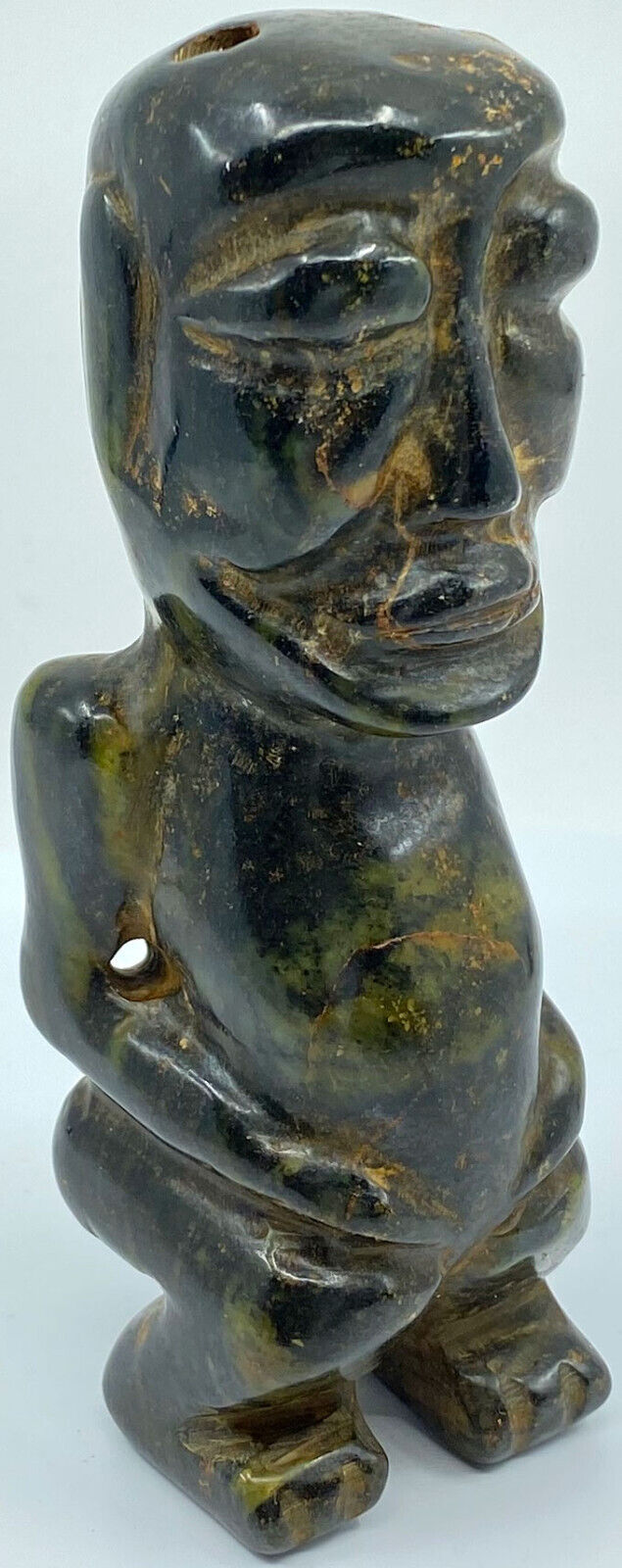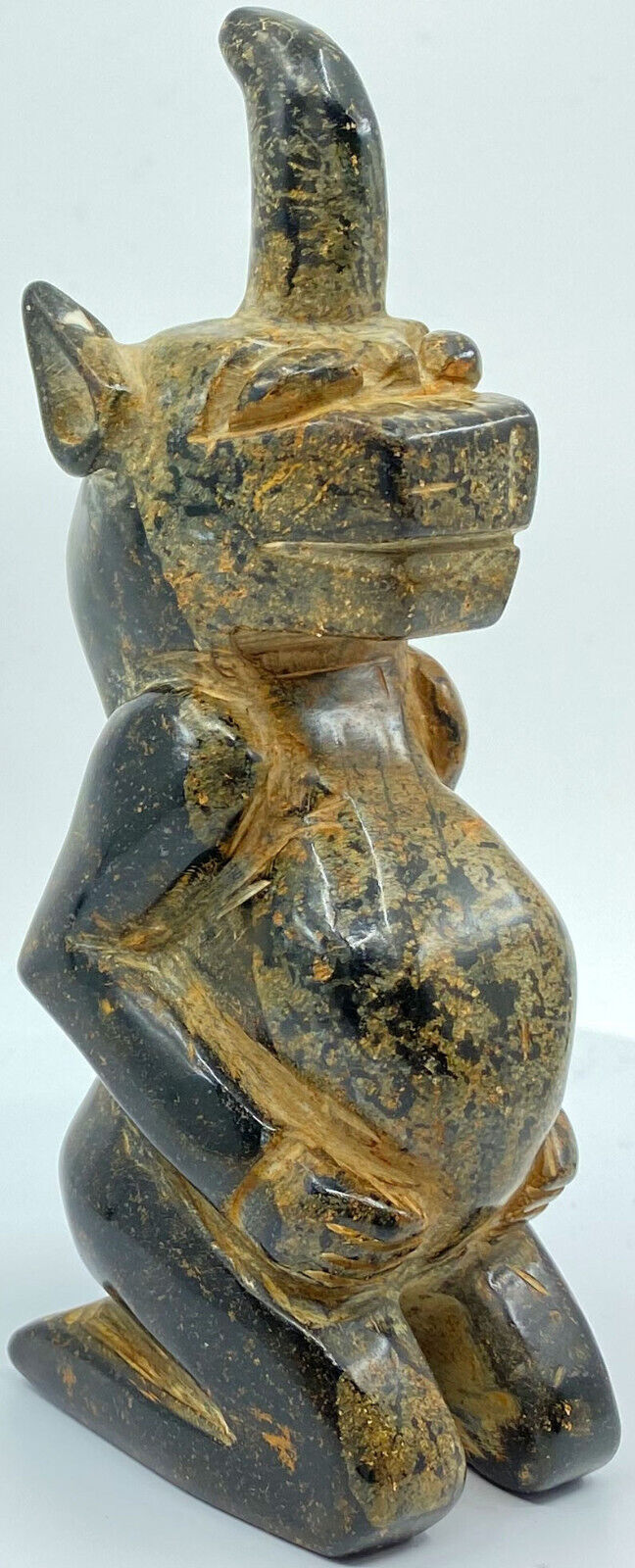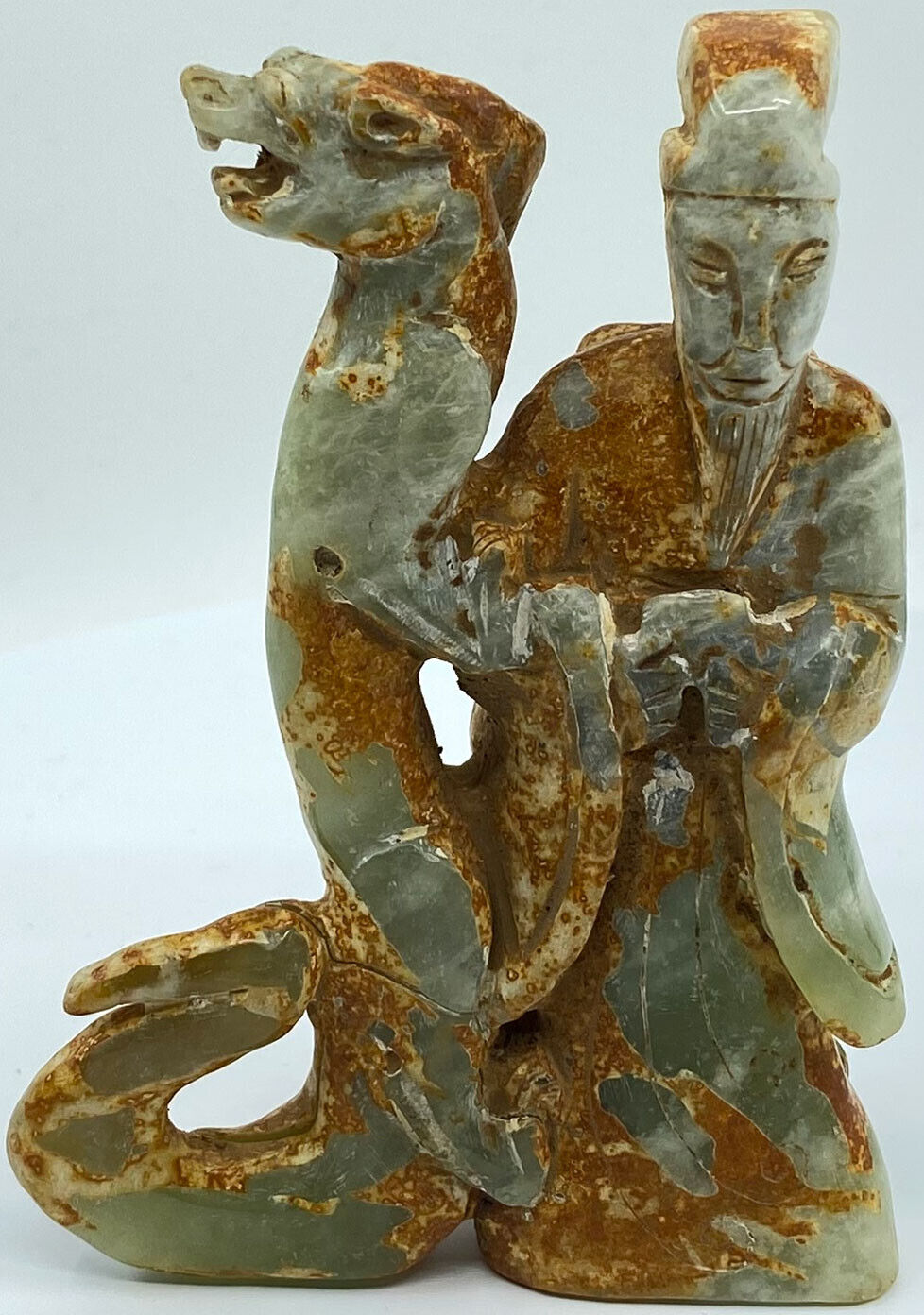|
China – Hongshan Culture – 4700BC – 2900 B.C.
Jade (or possibly other stone) Statue/Figurine5x3x12.2 centimeters (262.9 grams) Made circa 4700-2900 B.C.
Animal figurine.
Provenance: From private collection in the United States of America.
Ownership History: From private collection in the United States, bought in private sale in the United States of America.
You are bidding on the exact item pictured, provided with a Certificate of Authenticity and Lifetime Guarantee of Authenticity.
 The Hongshan culture (simplified Chinese: 红山文化; traditional Chinese: 紅山文化; pinyin: Hóngshān wénhuà) was a Neolithic culture in the West Liao river basin in northeast China. Hongshan sites have been found in an area stretching from Inner Mongolia to Liaoning, and dated from about 4700 to 2900 BC. The Hongshan culture (simplified Chinese: 红山文化; traditional Chinese: 紅山文化; pinyin: Hóngshān wénhuà) was a Neolithic culture in the West Liao river basin in northeast China. Hongshan sites have been found in an area stretching from Inner Mongolia to Liaoning, and dated from about 4700 to 2900 BC.
The culture is named after Hongshanhou (simplified Chinese: 红山后; traditional Chinese: 紅山後; pinyin: Hóngshān hòu), a site in Hongshan District, Chifeng. The Hongshanhou site was discovered by the Japanese archaeologist Torii Ryūzō in 1908 and extensively excavated in 1935 by Kōsaku Hamada and Mizuno Seiichi.
In northeast China, Hongshan culture was preceded by Xinglongwa culture (6200–5400 BC), Xinle culture (5300–4800 BC), and Zhaobaogou culture, which may be contemporary with Xinle and a little later.
The Yangshao culture of the Yellow River existed contemporaneously with the Hongshan culture (see map). These two cultures interacted with each other.
Hongshan culture was succeeded by the Lower Xiajiadian culture (2200–1600 BC), which was replaced by a different Upper Xiajiadian culture (1000-600 BC) with a shift from farming to pastoral nomadism, likely due to climate change. In the historical period, the West Liao basin was mainly populated by nomads.
A genetic study by Yinqiu Cui et al. from 2013 analyzed the Y-chromosome DNA haplogroup based N subclade; it found that DNA samples from 63% of the combined samples from various Hongshan archeological sites belonged to the subclade N1 (xN1a, N1c) of the paternal haplogroup N-M231 and calculated N to have been the predominant haplogroup in the region in the Neolithic period at 89%, with its share gradually declining over time. Today, this haplogroup is found in northern Han, Mongols, Manchu, Oroqen, Xibe and Hezhe at low frequencies. Other paternal haplogroups identified in the study were C and O3a (O3a3), both of which predominate among the present-day inhabitants of the region.
Nelson et al. 2020 attempts to link the Hongshan culture to a “Transeurasian” (Altaic) linguistic context.
A 2020 study discovered substantial genetic changes in the West Liao River region over time. An increase in the reliance on millet farming between the Middle-to-Late Neolithic is associated with higher genetic affinity to the Yellow River basin (associated with speakers of the Sino-Tibetan languages), while a partial switch to pastoralism in the Bronze Age Upper Xiajiadian culture is associated with a decrease in this genetic affinity. After the Late Neolithic, there was a sharp transition from Yellow River to Amur River-related genetic profiles around the West Liao River. This increase in Amur River affinity corresponds with the transition to a pastoral economy during the Bronze Age.
Similarly to the Yangshao culture, the Hongshan culture cultivated millet. Isotope analyses revealed that millet contributed up to 70% of the human diet in the Early Hongshan and up to 80% in the Late Hongshan.
The Hongshan culture is known for its carved jade. Hongshan burial artifacts include some of the earliest known examples of jade working. The Hongshan culture is known for its jade pig dragons and embryo dragons. Clay figurines, including figurines of pregnant women, are also found throughout Hongshan sites. Small copper rings were also excavated.
The archaeological site at Niuheliang is a unique ritual complex associated with the Hongshan culture.
Excavators have discovered an underground temple complex—which included an altar—and also cairns in Niuheliang. The temple was constructed of stone platforms, with painted walls. Archaeologists have given it the name “Goddess Temple” (Chinese: 女神庙; pinyin: nüshenmiao) due to the discovery of a clay female head with jade inlaid eyes. It was an underground structure, 1m deep. Included on its walls are mural paintings. Housed inside the Goddess Temple are clay figurines as large as three times the size of real-life humans. The exceedingly large figurines are possibly deities, but for a religion not reflective in any other Chinese culture.
The existence of complex trading networks and monumental architecture (such as pyramids and the Goddess Temple) point to the existence of a “chiefdom” in these prehistoric communities.
Painted pottery was also discovered within the temple. Over 60 nearby tombs have been unearthed, all constructed of stone and covered by stone mounds, frequently including jade artifacts.
Cairns were discovered atop two nearby two hills, with either round or square stepped tombs, made of piled limestone. Entombed inside were sculptures of dragons and tortoises.
It has been suggested that religious sacrifice might have been performed within the Hongshan culture.
Just as suggested by evidence found at early Yangshao culture sites, Hongshan culture sites also provide the earliest evidence for feng shui. The presence of both round and square shapes at Hongshan culture ceremonial centres suggests an early presence of the gaitian cosmography (“round heaven, square earth”).
Early feng shui relied on astronomy to find correlations between humans and the universe.
The Hongshan culture region was thought to have been desert for the past 1 million years. However, a 2015 study found that the region once featured rich aquatic resources and deep lakes and forests that existed from 12,000 years ago to 4,000 years ago. It was changed into desert by climate change which began approximately 4,200 years ago. Therefore, some of the people of the Hongshan culture may have emigrated south to the Yellow River valley approximately 4,000 years ago. Archaeological evidence discovered at the Miaozigou site in Ulanqab, Inner Mongolia, a northern branch of the Yangshao culture from the Yellow River (the Yangshao culture is speculated to be the origin of the Sino-Tibetan languages demonstrates similarities in the material cultures between the Yellow River and Liao River cultures. Three individuals from the Miaozigou site belonged to haplogroup N1(xN1a, N1c), while the main lineage of Yellow River valley cultures is O3-M122. The existence of N1(xN1a, N1c) among the Miaozigou individuals could serve as evidence for the migration of some of the Hongshan people.
Some Chinese archaeologists such as Guo Da-shun see the Hongshan culture as an important stage of early Chinese civilization. Whatever the linguistic affinity of the ancient denizens, Hongshan culture is believed to have exerted an influence on the development of early Chinese civilization.
The culture may have also contributed to the development of settlements in ancient Korea. However, the Hongshan culture is also commonly used in Korean pseudohistory by Korean scholars, who seek to contest the identification of Hongshan culture with the Chinese civilization and instead assert that the Hongshan culture is direct origin of a civilization which the direct ancestor of the polities found in early Korean history. These pseudohistory Korean scholars thus led to the popular discourse by incorporating the Hongshan culture into pre-existing paradigms, which had claimed the continental origins of the Korean people; moreover, they associated the Hongshan culture with the aggrandizing schemes of what is traditionally known as Gojoseon.
Since the latter half of the 2000s, there have been a second generation of unequivocal Korean pseudohistorians who have been promoting the Hongshan culture and has established it as a core topic of Korean prehistory; they have also replicated and augmented each interpretative fallacies found in previous works performed by Korean scholars Yi Hyonggu and Yun Naehyon, who had both started to incorporate the Hongshan culture into popular Korean discourse in the 1980s. The Korean pseudohistorians of the 2000s have further integrated those fallacies within the pre-estasblished periodization of ancient Korean history.
Since the year 2004, South Korean public have been perceiving the Northeast Project as an encroachment to what has been traditionally been considered as their ancient territories, which can be explained by the collective memory of the Japanese colonial period of Korean when Japanese scholars had control over the early history and archaeology field of both Korea and Manchuria.
|













 The Hongshan culture (simplified Chinese: 红山文化; traditional Chinese: 紅山文化; pinyin: Hóngshān wénhuà) was a Neolithic culture in the West Liao river basin in northeast China. Hongshan sites have been found in an area stretching from Inner Mongolia to Liaoning, and dated from about 4700 to 2900 BC.
The Hongshan culture (simplified Chinese: 红山文化; traditional Chinese: 紅山文化; pinyin: Hóngshān wénhuà) was a Neolithic culture in the West Liao river basin in northeast China. Hongshan sites have been found in an area stretching from Inner Mongolia to Liaoning, and dated from about 4700 to 2900 BC.




